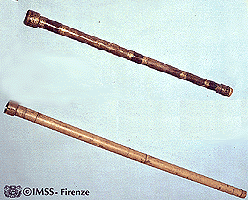Seeing the Universe
1608 - Galileo's hand held telescopes
In 1610, Galileo heard about a telescope a dutch optician had made. He
constructed his own telescopes and turned them to the heavens. The apparent
size of the universe immediately expanded. For the first time, sun spots, the
phases of Venus, mountains on the Moon and the four large moons of Jupiter
became visible. Galileo pioneered the use of telescopes in astronomy. So
thorough were his studies that for a time it was considered that he had
completely described the universe. Over the years, Galileo made many
telescopes and sold or gave most away. Two of his instruments held in
the Galileo Museum are shown in the photo. Note: Telescopes sold in toy
stores today show more detail than Galileo could see through his instruments.
![]() Galileo Project Home Page
Galileo Project Home Page

Two telescopes made by Galileo
(Rice University Galileo Project/Galileo Museum, Florence)